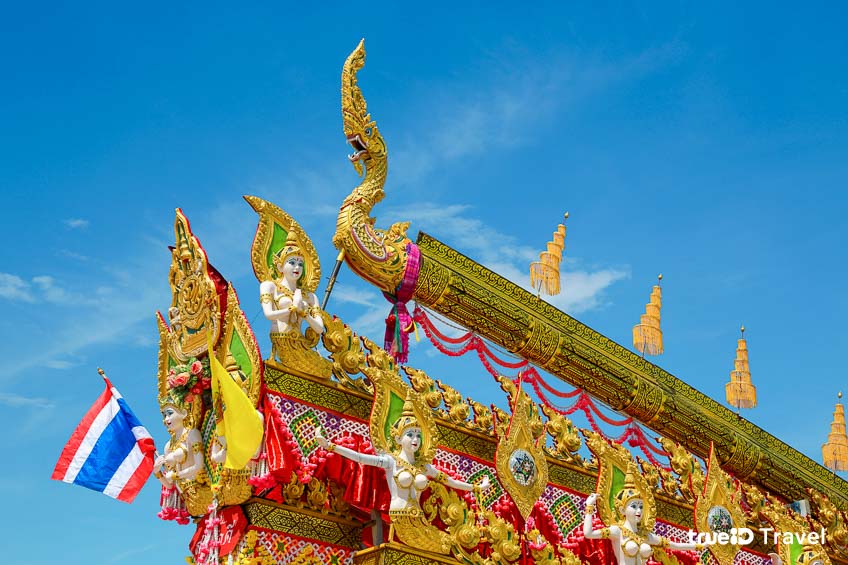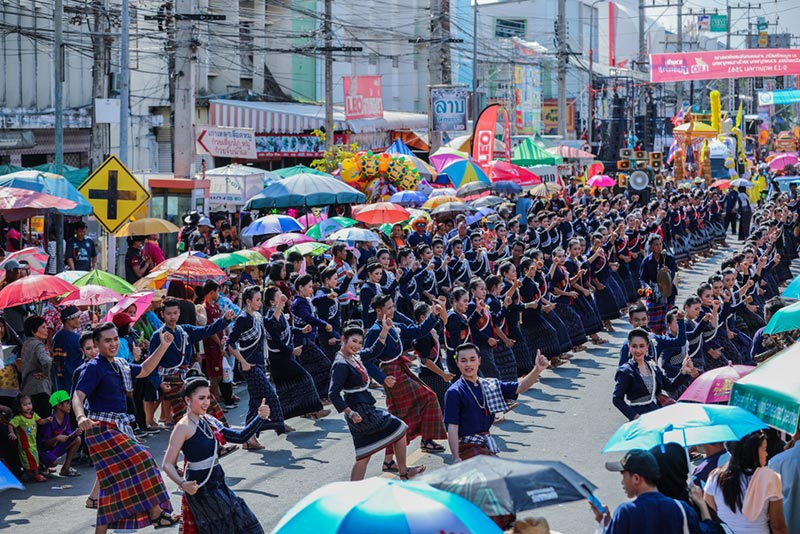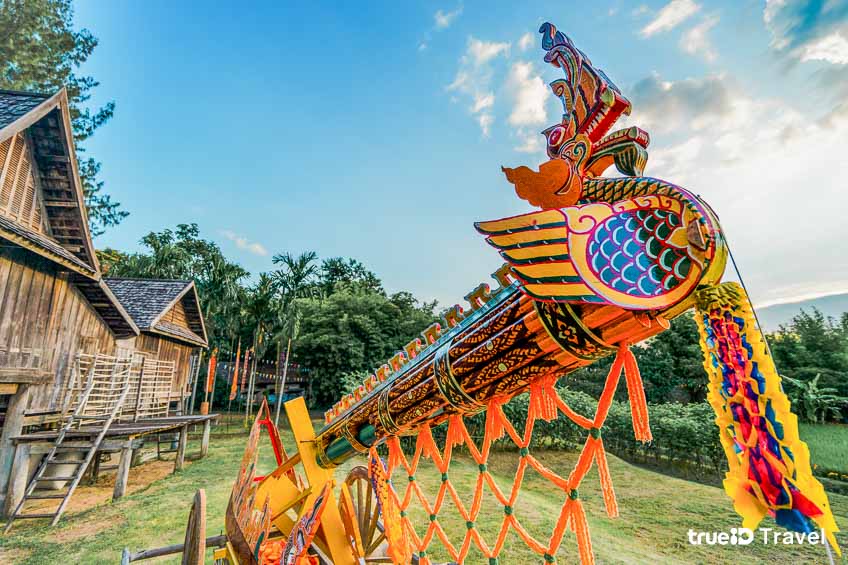Isaan Rocket Festival: An Ancient Promise of Rain

Ornately Decorated Bang Fai Float [cr. trueID Travel]
Home-made rockets bursting into the sky, mud fests for the losers, elaborate parades and dances with a splash of sexual innuendo and cross-dressing, and lots of rice wine… Bun Bang Fai (บุญบั้งไฟ), the Rocket Festival of Isaan (อีสาน), is amongst Thailand’s most spectacular events and one not to be missed.
Dating back to pre-Buddhist fertility rites, the Rocket Festival held in the Northeast of Thailand, also known as Isaan, and throughout Laos have become cultural extravaganzas that attract tens of thousands of visitors each year. Bun Bang Fai, held at the beginning of the rainy season to remind the God of Rain, Phaya Thaen (พญาแถน), of the promise he made a long time ago to nourish the fields, is the time for merit-making and fun before the hard work of rice farming begins.
An ancient legend of the people of the Mekong River basin passed down for thousands of years tells of the promise of rains made by Phaya Thaen. Phaya Khankhak (พญาคันคาก), also known as the Toad King, the prince of a legendary city called Inthapat Nakhon (อินทปัตถ์นคร), was born with toad-like skin. Through his perseverance of practicing Buddhist teachings, he was later transformed into the most handsome man on earth. All beings – humans, animals, and angels alike – were captivated by him, praising and idolising him to the extent that they forgot to pay homage and make sacrifices to Phaya Thaen as they normally did.
Phaya Thaen was outraged and prohibited Phaya Naga (พญานาค), King of the Serpents, from swimming in the heavenly pool. This caused a severe drought that lasted 7 years, 7 months, and 7 days, subjecting all human beings, animals and plants to great hardships.
Phaya Khankhak, therefore, had no choice but to wage a war with Phaya Thaen. He enlisted the help of both humans and animals. The termite colony built a great, long road that stretched up to the sky, allowing the combined armies to reach the heavens and beat Phaya Thaen.
Phaya Thaen accepted the defeat and negotiated an armistice. One of the conditions set by Phaya Khankhak was that the God of Rain would ensure adequate rains for the human world. Since then, whenever humans need rain, rockets are launched into the sky as a signal or a reminder to Phaya Thaen to keep his promise.
The Bun Bang Fai Festival
Bun Bang Fai Festival, or the sixth lunar month merit-making, was traditionally held for only two days, with the first dedicated to the bang fai parades, and the second to the launching of the rockets. If a village decided to organise a Bun Bang Fai event, nearby villages would be invited to join and bring their rockets.
On the evening of the first day, the host and the participating villagers would parade their rockets to the temple grounds where the event was held. This was a joyful activity showing harmony and solidarity among the villages. The parades included the Bang Fai dance and performances imitating the villagers’ way of life such as fish net weaving and trap making. There were also jokes and songs with sexual innuendo. Wood carvings in the shape of a penis known as ‘buk paen’ (บักแป้น) or ‘palad khik’ (ปลัดขิก) were carried in the processions. It has been explained that these objects are symbols of the relationship between heaven and earth, and men and women, of the life-generating force and the power of fertility.

Bun Bang Fai Parade [cr. kapook]
The next day, the villagers, both men and women, the hosts and the guests, dressed in their finest and brought food and other offerings to the monks at the temple. After that, the rockets were taken out to the yard, where platforms were erected to mount them. Once all the rockets had been fired into the sky, the Bun Bang Fai festival for that year was considered at an end.
Today, while Bun Bang Fai is still held at village and district levels and features the same rituals, the events held at the provincial level have become bigger, more elaborate, and very famous. The simple parades have now grown into lavish floats with beauty queens and dancers. The link to the ancient fertility rite now includes cross-dressing, outrageous costumes, and creative phallic arts. Some rocket festivals have become highlights in the Thai tourism calendar, such as the Bun Bang Fai Festival of Yasothon and Roi-Et Provinces.
The Anatomy of the Bang Fai
A Bang Fai is a skyrocket, a type of long-tailed firework, made of several parts.
- Lao bang fai (เลาบั้งไฟ) – the body – is the part that contains the gunpowder. It is a long round cylinder, about 1.5 – 7 meters long, traditionally made from bamboo poles tied together with bamboo ropes. Gunpower is then pressed firmly into the cylinder and the fuse is attached before the body and the tail are joined.
Nowadays, other materials are also used apart from bamboo, such as steel and plastic pipes, which make it easier to load the gunpower and fire the rocket with more efficiency.
- Hang bang fai (หางบั้งไฟ) – the tail – is considered an important part, acting like a rudder of a ship, balancing the rocket so it shoots straight and skywards. The original rocket tail was made of whole bamboo. Later, steel and a combination of steel and wood were also introduced. The length of the tail is around 8-12 meters.
- Luk bang fai (ลูกบั้งไฟ) – the babies – are bamboo cylinders assembled around the body of the rocket and serve as a surface for decoration. A rocket may have about 8-15 babies, depending on its size.

Bang Fai [cr. trueID Travel]
A Tradition That Reflects a Way of Life
The Isaan people believe in the worlds of humans and angels. They believe that we humans are at the mercy of the angels, or Thaen, with Phaya Thaen being the highest deity. All natural phenomena such as rains and storms are controlled by the angels. If the angels are pleased, people can live happily. The origins of traditional practices such as the Phi Fah dance ritual and the Bun Bang Fai festival can be traced back to this belief.
The Bun Bang Fai tradition also reflects the North-East’s history as an agricultural society where seasonal rainfall was crucial for the cultivation of rice and other crops. Even though many Thai people have adopted a non-agrarian lifestyle, the Rocket Festival has retained its importance. Amidst worsening climate change with forests being cut down, droughts becoming more widespread, and dams running dry, appeasing the God of Rain to get more water from the sky is not a bad idea after all.

Shooting Bang Fai [cr. kukrit.com]
**************************
References
Kangwarn, Chakraband. Bun Bang Fai Isaan Karn Tuang Sun Ya Jark Phuen Din Suu Sa Wun [Isaan Rocket Festival: An earthly way to claim Heaven’s promises]. Watthanatham Journal: Department of Cultural Promotion, vol. 55, no. 3, July-September 2016, p. 48-55. Available at http://magazine.culture.go.th/2016/3/mobile/index.html#p=51.
Heet Sib Song Krong Sib See: Bun Bang Fai [Thai Traditional Rocket Festival]. Mahasarakham Provincial Cultural Office, 11 December 2019. Available at https://www.m-culture.go.th/mahasarakham/ewt_news.php?nid=2167&filename=index.


